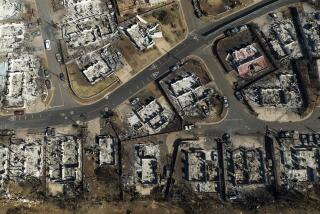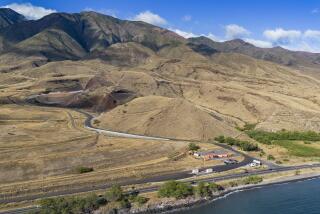Maui Means Business in Attracting More of It : Industry: Tourist paradise touts lack of urban troubles, location halfway between major Pacific Rim economies.
It seems like a far-fetched idea: escape the traffic, smog and crime of Orange County and run away to some tropical island.
Fine for a retiree or a beach bum. But an entire business operation?
Economic development officials in Maui, Hawaii, say there are practical as well as pleasurable reasons to set up a business on the island best known for its tourist trade.
Maui, they say, is at the center of the Pacific Rim economies of the western United States and Asia. It lacks many of the problems of urban areas. And, more recently, the state has been dangling attractive incentives to lure business.
Now, island officials have targeted Orange County because it has the types of businesses they want: computers, alternative energy, medical technology, biotechnology and environmental engineering.
“Maui is like the San Fernando Valley in the 1930s,” said Michael Boughton, a former TRW executive who now lives on the island as the director of the Maui Economic Development Board. “It is just starting to come alive, and will come alive.”
Maui, he says, isn’t just a place of grand hotel resorts, sugar plantations and the dormant Mount Haleakala volcano. It is “still rural, more sparsely populated and less of a hassle. We don’t have freeways and we don’t have traffic jams.”
But the Orange County group, comprising half a dozen public relations officials and business consultants, will need to do more than show slide presentations of pristine beaches to get firms to Hawaii.
“The lifestyle is kind of obvious,” said Bob Gilchrist, a Costa Mesa business consultant and chairman of the Orange County group. “I don’t even talk about the lifestyle. There’s got to be a basic business equation. It can be the gateway to the Pacific Rim.”
Gilchrist, who will host a seminar on Maui at the Irvine Marriott on April 29, points to the island’s advanced communications system and its diverse culture and geography, the latter placing it in a time zone that enables business people to phone both the mainland United States and Asia during regular work hours.
But the gemstone is the new Maui Research and Technology Park, a 330-acre site near the town of Kihei and one of only three such ventures in Hawaii. The federal government is funding a $19.5-million park project involving a supercomputer that will be used in medicine, astronomy and multimedia animation.
The park also includes the $10-million, state-funded Research and Technology Center, which opened in November. The center is attempting to lure Southern California companies to its business “incubation” facility, which provides shared office equipment, conference rooms, secretarial and other support services for start-up firms.
The center also includes a telecommunications center, a facility designed to help established businesses get started in Hawaii and an academic network that gives companies access to University of Hawaii and Maui Community College researchers.
Another attraction touted by Maui officials is a state program that offers young companies up to $1 million in low-interest loans and attractive payment schedules.
Convincing chief executives to take Maui seriously as a place for high-tech companies may not be easy. Tourism is far and away its major industry, with about 2.4 million visitors a year.
“Hawaii is considered somewhat whimsically,” said Dale C. Webster, assistant manager of the research and technology center. “The perceptions are of swaying palm trees and walking on beaches.”
Only recently has the state’s Department of Business, Economic Development and Tourism made a concerted effort to attract businesses as well as tourists. Whereas $20 million is spent annually on promoting tourism, as recently as 1984 only $50,000 was devoted to business growth, state officials said. Now, the state spends up to $2 million annually to promote business.
“We’ve been so successful in projecting our sun, sand and surf image, it’s tough to get people to realize that it’s a serious place to do business,” said Richard Bahar, a state business development specialist. “Many people who have moved their business here become familiar with Hawaii during their vacations. Then they see that ‘Hey, this is a serious place too.’ ”
Kinetix Instruments, a Santa Clara medical equipment company, is moving to a business incubation facility on Oahu, lured by a $1-million state loan and “less red tape” in the permit process, said President Michael Billingsley.
But the prime factor was access to the Pacific Rim, where the company hopes to expand its sales of orthopedic instruments used to treat people with repetitive stress injuries.
“It’s really vibrant,” said Billingsley. Hawaii “is going to be a major trading center.”
But Maui is not without its drawbacks. The island has no freeways and an aging sewage and water system that needs improvement. And local companies complain of a shortage of labor, resulting from rapid development and high housing costs.
Billingsley found that a $250,000 home in Santa Clara costs $400,000 on Oahu. That type of housing price shock also concerns Maui officials, but they hope the island’s quality of life will outweigh such drawbacks.
Even so, Maui may not be for everyone. Most businessmen wear print shirts instead of white collars. And transplants find it more down to earth.
“People value friendships more than the rat race,” said Webster, who moved to the island almost two years ago. “It’s reflected in the rate of ulcers and heart attacks. The rate is much lower here.”
Maui County at a Glance
Size: 1,161 square miles on four islands--Maui, Molokai, Lanai and Kahoolawe--together about the size of Rhode Island.
Population: 100,374 (1990).
Climate: Warm, dry in beach areas; semitropical and wet on windward mountains.
Average temperature: Lahaina, January-February, 71 degrees; August-September, 76 degrees.
Primary industry: Tourism. About 2.3 million visitors annually.
Labor Force: Civilian labor force of 55,000. Island of Maui has experienced labor shortages because of economic growth and lack of affordable housing.
Housing: Estimated median market value of owner-occupied units (1990), $275,000; median rent, $810.
Source: Maui County, Hawaii.
More to Read
Inside the business of entertainment
The Wide Shot brings you news, analysis and insights on everything from streaming wars to production — and what it all means for the future.
You may occasionally receive promotional content from the Los Angeles Times.










